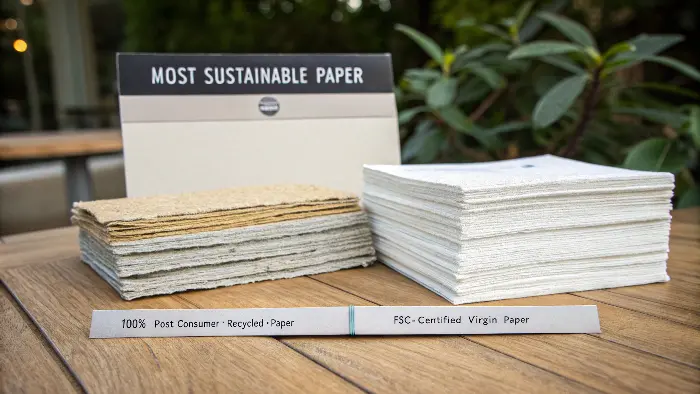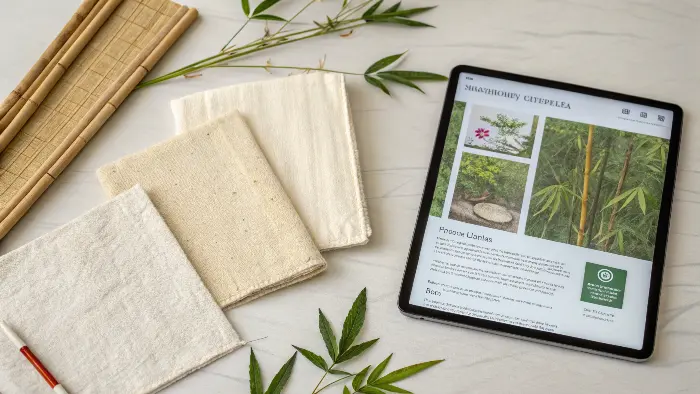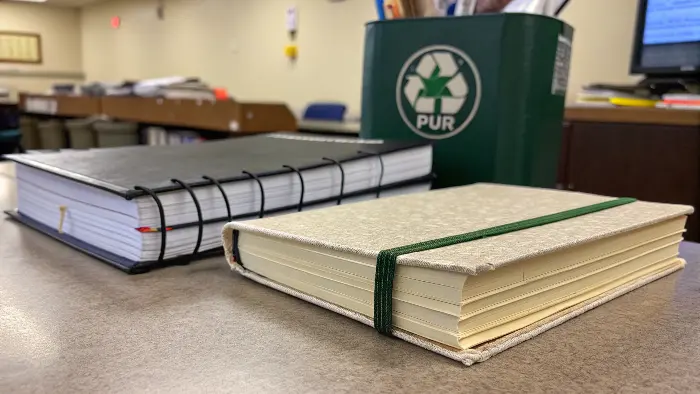Want to publish your book without harming the planet? Traditional methods can be wasteful. Choosing eco-friendly options feels right, but where do you even begin?
Sustainable bookbinding uses recycled materials, less glue, and energy-efficient processes. Options like saddle stitch or PUR binding with recycled paper make a significant difference.
It’s a bit like when we’re designing a new line of Panoffices notebooks. Michael, our Product Development Manager in Germany, always asks, "What are the most sustainable yet durable options?" He’s seen the demand for greener products skyrocket in Europe. And it’s not just a trend; it’s a responsibility. So, if you’re looking to publish, thinking about the environmental impact of your binding choice is a great step. Let’s explore some practical ways to do this.
How do you publish a book sustainably?
Dreaming of seeing your book in print, but worried about the environmental cost? Traditional publishing isn’t always green. It’s a real concern for conscious creators.
Publish sustainably by choosing recycled/FSC-certified papers, eco-friendly inks, energy-efficient printers, durable eco-bindings like saddle-stitch or PUR, and considering print-on-demand to reduce waste.
Publishing a book sustainably isn’t just a single action; it’s a series of conscious choices throughout the entire production process. It’s something we discuss a lot at Panoffices when sourcing materials for our stationery. For example, Michael is always on the lookout for suppliers who can offer not just recycled content but also demonstrate responsible manufacturing. For books, this means looking beyond just the paper. Think about the inks – are they vegetable-based or petroleum-based? Are the printing facilities using renewable energy or implementing waste reduction programs? Even choosing print-on-demand (POD) can be a sustainable choice, as it means books are only printed when an order is placed, drastically reducing the risk of unsold copies ending up in landfill. And then, of course, there’s the binding! My insights suggest that options like saddle stitching, PUR adhesive binding (Polyurethane Reactive), and even some section-sewn methods can be more eco-friendly, especially when paired with recycled papers. Saddle stitching, for instance, uses minimal materials (just staples and the paper itself), making it a very low-impact choice for thinner books and booklets. PUR binding is known for its strength and flexibility, using less adhesive than traditional EVA hotmelts, and it works well with recycled papers. These methods can reduce waste and energy consumption. It’s about a holistic approach – every little bit helps!
What is the most sustainable paper for printing?
Want your book’s pages to be as green as its message? Choosing paper is a big deal. With so many options, finding the most sustainable can be confusing.
The most sustainable paper is typically 100% post-consumer recycled paper. FSC-certified virgin paper from responsibly managed forests is the next best, ensuring minimal environmental impact.

This is a question Michael asks us all the time when we’re developing new Panoffices notebooks! "What’s the best eco-paper that still gives a premium feel?" he’ll say. And it’s a great question. For books, the answer is pretty similar. Hands down, 100% post-consumer recycled paper is often touted as the top choice. This means no new trees were cut down to make it, and it diverts waste from landfills. The quality of recycled paper has improved massively over the years too – it’s not all grey and scratchy anymore! You can get bright white, smooth recycled papers that are perfect for printing. If 100% recycled isn’t feasible or doesn’t meet specific quality needs (though it often can!), the next best thing is paper certified by the Forest Stewardship Council (FSC). FSC certification ensures that the virgin pulp used comes from forests that are managed responsibly, considering biodiversity, indigenous peoples’ rights, and long-term forest health. There are different FSC labels too:
- FSC 100%: All material is from FSC-certified forests.
- FSC Recycled: All material is recycled (can be pre- or post-consumer).
- FSC Mix: A mix of FSC virgin fiber, recycled material, and/or controlled wood.
Look for these labels! Other factors include the bleaching process (Processed Chlorine Free – PCF, or Totally Chlorine Free – TCF are best) and the paper’s weight – lighter paper generally means less raw material used. It’s about finding that balance between sustainability, aesthetics, and performance.What is a sustainable alternative to paper?
Thinking beyond traditional paper for your book? While paper is common, exploring alternatives can be innovative. But what truly sustainable options exist beyond recycled paper?
Truly sustainable alternatives to virgin tree-pulp paper include bamboo, hemp, cotton linters (from textile waste), or agricultural residue papers. Digital formats are also an alternative to physical printing.

This is where things get really interesting! While recycled paper is fantastic, the quest for even more sustainable materials is always ongoing. At Panoffices, we’re tentatively exploring some of these for specialty items, though availability and cost can be factors. For book publishing, some of these are still niche but gaining traction:
- Bamboo Paper: Bamboo is a fast-growing grass that regenerates quickly without needing replanting. It requires less water and fewer pesticides than trees. Bamboo paper can be strong and smooth.
- Hemp Paper: Hemp is another rapidly renewable resource. It’s been used for papermaking for centuries! Hemp fibers are long and strong, producing durable paper. Plus, hemp cultivation can actually benefit the soil.
- Cotton Linter Paper: Cotton linters are the short fibers left on the cottonseed after ginning. Using this byproduct of the cotton industry for paper means less waste. It creates a soft, high-quality paper often used for fine art or archival purposes.
- Agricultural Residue Papers: This involves using waste products from agriculture, like straw (from wheat or rice), bagasse (sugarcane waste), or even banana pseudo-stems. This turns waste into a valuable resource.
- Stone Paper: This is a bit different – it’s made from calcium carbonate (limestone) bonded with a small amount of non-toxic resin (HDPE). It’s tree-free, water-free in its production (mostly), and recyclable. However, its end-of-life biodegradability and the energy used in production are points of discussion.
And of course, there’s the ultimate "alternative" to physical paper: digital formats like e-books and audiobooks. They have their own energy footprint (servers, devices), but they eliminate the material impact of paper, printing, and shipping entirely. It really depends on the project and the audience. Michael often says, "For some of our clients, the tactile feel of a premium paper notebook is non-negotiable, but for others, a digital solution might be part of their strategy."Is perfect binding sustainable?
Is your go-to perfect binding actually eco-friendly? It’s common for paperbacks, but its glue and process raise questions. Can this popular method be a green choice?
Perfect binding can be more sustainable if PUR adhesive (which uses less glue and is stronger) is used, paired with recycled papers, and VOC-free glues. Traditional EVA hot-melt glues are less ideal.

Ah, perfect binding! It’s the standard for so many paperbacks and even some of the journals we produce at Panoffices. The question of its sustainability is a good one, and the answer is… it depends. Traditional perfect binding often uses EVA (ethylene vinyl acetate) hot-melt adhesives. These require a fair amount of glue, and the recycling process for books with these spines can sometimes be a bit more challenging, though not impossible. However, there’s a greener star in the perfect binding world: PUR (Polyurethane Reactive) adhesive.
Here’s why PUR is generally considered a more sustainable choice for perfect binding:
- Less Glue Needed: PUR is incredibly strong, so you need a much thinner layer of adhesive compared to EVA to achieve a durable bind. Less material means less environmental impact.
- Stronger, More Flexible Bind: This means books last longer, reducing the need for replacements. The flexibility also means books lay flatter, which is a nice user benefit.
- Better Performance with Coated and Recycled Papers: PUR adheres well to a wider variety of paper stocks, including glossy coated papers and many recycled papers, which can sometimes be tricky for EVA glues.
- Lower VOCs (Volatile Organic Compounds): Many PUR adhesives have lower VOC content than some older EVA formulations, which is better for air quality in the production facility and for the environment generally.
So, if you’re opting for perfect binding, asking your printer if they use PUR adhesive is a great step. Combine that with recycled or FSC-certified paper for the text block and cover, and you’re making perfect binding a much more sustainable option. My insight mentioned that PUR adhesive binding (聚氨酯胶装) is a good eco-friendly choice, and this aligns perfectly. For very thin publications, saddle stitching still wins on material minimalism, but for thicker books where perfect binding is needed, PUR is the way to go for a greener profile. It’s about making informed choices with the available tech!Conclusion
Choosing eco-friendly binding, recycled paper, and sustainable printing methods significantly reduces publishing’s environmental footprint. Small changes create a big impact for a greener book industry.

